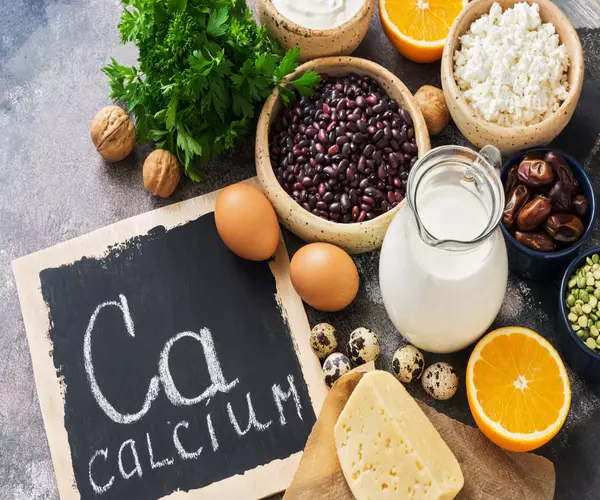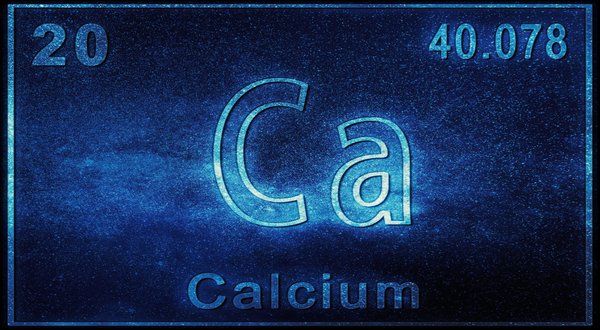What is Calcium?
- Calcium is the most abundant among the minerals in the body.
- The total calcium content in an adult man is about 1 to 1.5 kg.
- As much as 99% of it is present in the bones and teeth.
- A small fraction (1%) of calcium outside the skeletal tissue performs various functions.

Biochemical functions
- Development of bones and teeth: Calcium, along with phosphate, is required for the formation and physical strength of skeletal tissue. Bone is a mineralized connective tissue. Osteoblasts are responsible for bone formation while osteoclasts result in demineralization.
- Blood coagulation: Several reactions in the cascade of the blood clotting process are dependent on Ca2+ (factor IV). Calcium is factor 1v in the coagulation cascade.
- Activation of enzymes: Calmodulin is a calcium-binding regulatory protein. Calcium is needed for the direct activation of enzymes such as lipase (pancreatic), ATPase and succinate dehydrogenase.
- Nerve transmission: Calcium is necessary for the transmission of nerve impulses from pre-synaptic to post-synaptic region.
- Secretion of hormones: Ca mediates the secretion of insulin, parathyroid hormone, and calcitonin from the cells.
- Membrane integrity and permeability: Ca influences the membrane structure and transport of water and several ions across it.
- Action on heart: Ca acts on the myocardium and prolongs systole. In hypercalcemia, cardiac arrest is seen in systole.
- Second messenger in signal transmission: Ca and cyclic AMP are second messengers of different hormones. E.g, glucagon.
Dietary requirements
- Adult men and women — 800 mg/day
- Women during pregnancy, lactation and post-menopause — 1.5 g/day
- Children (1-18 yrs.) — 0.8–1.2 g/day
- Infants (1 year) — 300–500 mg/day
Dietary Sources
- Best sources — Milk and milky products
- Good sources — Beans, leafy vegetables, fish, cabbage, and egg yolk

Absorption
Site: first part and second part of duodenum. Ca absorbs against concentration gradient and requires energy and a carrier protein.
Factors that increase the absorption rate
- Vitamin D (through its active form calcitriol) induces the synthesis of ca-binding protein in the intestinal epithelial cells and promotes Ca absorption.
- Parathyroid hormone enhances Ca absorption through the increased synthesis of calcitriol.
- Acidity (low pH) is more favourable for Ca absorption.
- Lactose promotes calcium uptake by intestinal cells.
- The amino acids lysine and arginine facilitate Ca absorption.
Factors that decrease the absorption rate
- Phytates and oxalates form insoluble salts and interfere with Ca absorption.
- High content of dietary phosphate the dietary ratio of Ca and P—between 1: 2 and 2: 1—is ideal for optimum Ca absorption by intestinal cells.
- The free fatty acids react with Ca to form insoluble calcium soaps.
- Alkaline condition (high pH) is unfavourable for Ca absorption.
- High content of dietary fibre.
Plasma calcium
Most of the blood Ca is present in the plasma since the blood cells contain very little of it.
- Normal serum/plasma level of calcium: 9-11 mg/dl (4.5-5.5 mEq/l).
- Ionized calcium: 5mg/dl
- Protein-bound calcium: 4mg/dl
Clinical Condition
1. Hypercalcemia
When serum Ca level is more than normal level.
Causes: Hyperparathyroidism, multiple myeloma, secondary bone cancer, Paget’s disease.
Neurological symptoms: Depression, Confusion, Irritability, Generalised muscle weakness.
GIT: Nausea, vomiting, abdominal pain, anorexia.
The symptoms of hypercalcemia include lethargy, muscle weakness, loss of appetite, constipation, increased myocardial contractility and susceptibility to fractures.
2. Hypocalcemia
Hypocalcemia is a more serious and life-threatening condition. It is characterized by a fall in the serum Ca to below 7 mg/dl, causing tetany. The symptoms of tetany include neuromuscular irritability and convulsions.
Symptoms of Hypocalcemia:
- Myalgia (muscle pains/aches), spasms, and cramps in the legs and thighs. In extreme cases, hypocalcemia can involve nerves, causing tingling sensations in the fingers and toes.
- Fatigue and tiredness. It is also associated with depression in certain cases.
- Brittle nails, poor skin conditions, and alopecia (hair loss) on extremes.
- Weak teeth, tooth decay, and poor oral hygiene with weak gums.
Causes:
Accidental surgical removal of parathyroid
- Pseudohypo parathyroids—lack of end-organ response
- Renal disease
- Vitamin D deficiency
- Osteoporosis
- Renal rickets
- Rickets: Rickets is a disorder of defective calcification of bones. Mostly seen in children, rickets result in soft and weak bones. It’s like building a house with unsteady foundations. This may be due to low levels of vitamin D in the body or a dietary deficiency of Ca and P — or both.
- Tetany: The symptoms of tetany include neuromuscular irritability, convulsion and muscular cramps.
3. Osteoporosis: Osteoporosis is characterized by demineralization of bone resulting in the progressive loss of bone mass. This condition causes weak and fragile bones, increasing the risk of falls and fractures.
Occurrence: Elderly people (over 60 yr.) of both sexes are at risk for osteoporosis. However, it predominantly occurs in post-menopausal women. Osteoporosis results in frequent bone fractures which are a major cause of disability among the elderly.
References
- https://recnotes.com/wp-content/uploads/2020/11/Biochemistry-U-Satyanaryan-4th-Edition.pdf
- Ca: MedlinePlus
- Ca: Mayo clinic
- What is Ca?: Food Insight
- Ca rich foods: Cleveland Clinic


1 thought on “Calcium: An Overview”